Discover Health and Prosperity that Supports Biodiversity
Increase vitality, clarity, beauty, lose belly fat and weight with a healthy recipe that saves time, money, resources and helps prevent disease
What food is a pseudo-cereal, but is really a seed?
Quinoa (Chenopodium quinoa), genus name Chenopodium is composed of two words coming from the Greek χήν,-νός, goose and πόδῖον, podion "little foot", or "goose foot", because of the resemblance of the leaves with a goose's foot.
Chenopods are a diverse group of plants that are a part of the Amaranth family, and are an edible seed, a complete protein that provides all nine essential amino acids, has several minerals, including manganese, phosphorus, copper, folate, calcium, iron, magnesium, potassium, thiamine, riboflavin, zinc, as well as fiber, oil, complex carbohydrates, vitamins E, B, C, carotenoids, tocopherol, flavonoids and antioxidants Quercetin*, Kaempferol, Squalene, maintaining healthy bones, teeth, immune system, and aiding in energy production.
*Note: “Quercetin (Que) and its derivatives are naturally occurring phytochemicals with promising bioactive effects, as shared in Therapeutic Potential of Quercetin: New Insights and Perspectives for Human Health. The antidiabetic, anti-inflammatory, antioxidant, antimicrobial, anti-Alzheimer’s, antiarthritic, cardiovascular, and wound-healing effects of Que have been extensively investigated, as well as its anticancer activity against different cancer cell lines has been recently reported.”
There are several types of quinoa, with the most widely grown types are white, red, black and tri-color, which is a combination of the three. Follow a simple guideline in food: the darker the color, the higher the antioxidant capacity. Seeds are life waiting to give to us! They are full of energy, nutrition, and are regenerative, plentiful to procure and grow.
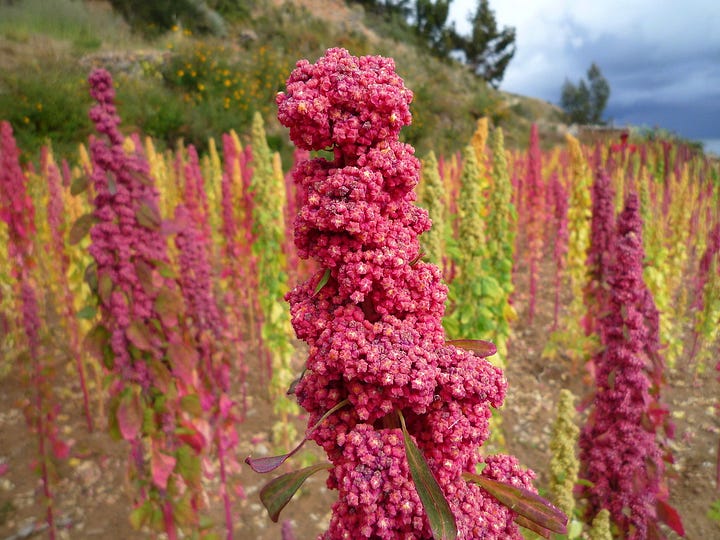

Quinoa was first grown for human consumption around 3,000-4,000 years ago, and, 5,200- 7,000 years ago for animals in the Andean region. The Incas called it chisiya mama, which roughly means “the mother grain” and believed it was sacred.
The young leaves are also nutritious and can be eaten as a vegetable similar to spinach. They can be steamed or sautéed and are similar in taste and texture to spinach or beet greens. Quinoa is an annual herbaceous plant that can reach up to 3 meters (9.8 feet) in height.
The tiny seeds, produced in achene fruits, are about 2 mm (0.08 inch) in diameter and can be white, red, yellow, purple, brown, or black. Quinoa has an extensive branching taproot that can be up to 1.5 meters (5 feet) deep, is drought tolerant, frost-resistant, salt-tolerant and can be grown in poor soils, making the species attractive to numerous food security programs.
The U.S. National Aeronautics and Space Administration (NASA) has expressed interest in quinoa for its potential to support crews on long-term missions.
Quinoa has several industrial applications due to its high levels of bitter saponins. “Waste saponins” can be used to produce soaps, cosmetics, beer, and many other products.
Quinoa is versatile, has a nutty flavor, can be made in sweet or savory dishes, and is usually boiled and added to salads, thicken soups, as a side dish, in baked goods or porridge.
Whole plant foods are good for you and an adequate fiber intake may benefit your digestion, reduce your risk of chronic disease and help maintain a healthy weight. Many of these benefits are mediated by your gut microbiota-the millions of bacteria that live in your digestive system. Not only does it feed your gut bacteria, it nourishes your colon wall.
Food can calm or it can inflame. Inflammation is at the core of many health issues like pain, arthritis, heart and brain disorders. Quinoa is anti-inflammatory, has a low glycemic index and is gluten-free.
Find your pulse and improve health and biodiversity!
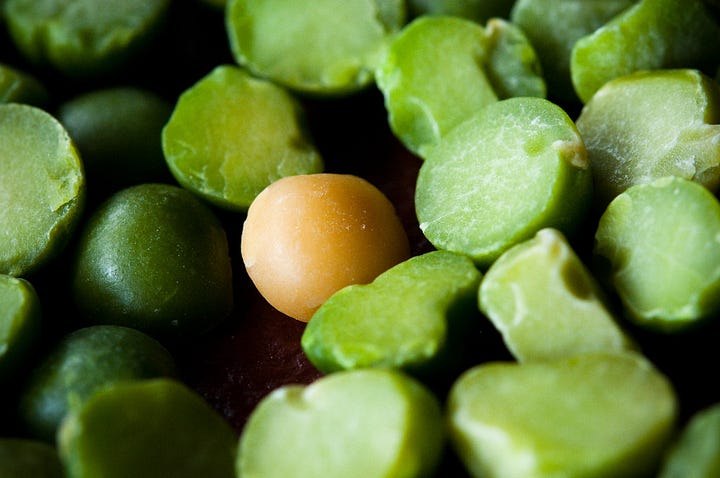
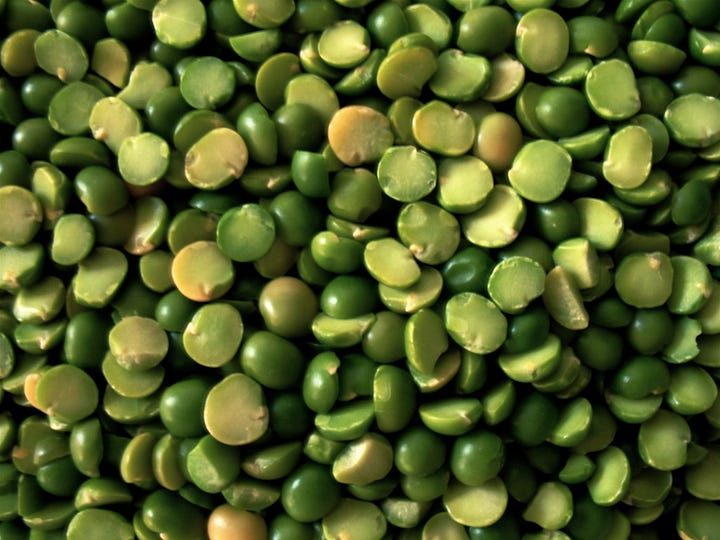
Split peas are the edible seeds of pulses. “The first evidence of pulses comes from 11,000 years ago in the Fertile Crescent, a region in the Middle East which was home to some of the earliest human civilizations.” They are low in fat, cholesterol, sodium, are high in protein, fiber, provide vitamins and minerals including zinc, magnesium, potassium, folate and iron. Growing pulses also promotes sustainable agriculture, as pulse crops help reduce the need for nitrogen fertilizers, increase soil health, and use less water than other crops.
Most of our calories come from protein and complex carbohydrates. The split pea is known to be a natural food source that contains some of the highest amounts of dietary fiber. Foods rich in complex carbohydrates, like quinoa and split peas, provide the body with sustained energy levels and are rich sources of energy-boosting starch.
Dried peas are anti-inflammatory, lower systolic blood pressure, reduce pain and arthritis, reduce levels of cholesterol, and may reduce the risk of heart disease, dementia and diabetes. Like quinoa, the dietary fiber in split peas can also help with weight management, which can contribute to a lowered risk of various cancers, colorectal cancer specifically.
A 1/2-cup cooked serving of split peas contain approximately 8.3g of protein. Quinoa has 4g of protein per a 1/2 cup. One cup of cooked pulses gives you more than half the amount of fiber you need for the entire day. Compared to animal and many other plant-based sources of protein, pulses are a more affordable and sustainable protein source.
Energize with a simple healthy meal and feed the mind-body-spirit to honor yourself, life, nature, animals, soil, food, water, air, health and well-being.
Quinoa-Dried Split Peas-Cauliflower Salad
Split peas cook faster than other legumes and do not need to be soaked before cooking. If you prefer to soak them, please do. Rinse your split peas to wash away any dirt and debris before preparing them.
To cook split peas and quinoa, use a 1:2 ratio of liquid (water or broth). You can cook them on the stovetop, pressure cooker, or slow cooker. Add liquid if you cook longer as it gets soaked up by the quinoa and peas.
To cook on the stovetop, place the quinoa, dried split peas and water (or broth) in a pot. Bring to a boil and then let simmer (about 25 minutes) until the quinoa and peas are thoroughly cooked through- stir and check regularly. This simple cooked quinoa-peas-cauliflower recipe can be added on a raw salad of finely chopped greens, red cabbage and beets. If you prefer to cook the “salad”, add them to the pot last, and cook on low for about 10 minutes, or to preference. People with diverticulitis and other digestive issues may need to cook food longer. Serves 2. For soup, add more liquid.
Quinoa-Dried Split Peas-Cauliflower Salad Ingredients
2 cups of water or broth (I cook intuitively and don’t always measure, watch the liquid levels as the quinoa and dried peas cook. Add additional liquid as needed or to preference)
½ cup of Red Quinoa, rinsed.
½ cup of dried Split Peas, rinsed.
½ cup of rinsed and chopped Cauliflower.
Cook quinoa, peas and cauliflower in one pan.
For salad (measurements are flexible):
2 cups finely chopped greens: spinach, chard, kale
4-6 thin slices of organic red beets, diced
½ cup of red cabbage, diced
Mix in a bowl: the salad, extra virgin olive oil, a quarter of a lemon squeezed, then add the quinoa-peas-cauliflower on top. If you cooked the “salad”, then everything will already in one pot and ready to serve after you sprinkle on cumin, turmeric, nutritional yeast, salt and pepper to taste. I also like to use a few shakes of Everything Bagel seasoning (in the spice section of the grocery or Vitacost).
This meal is versatile, so add your own touches and preferences.
These foods help me increase and sustain my energy, think clearly and lose some belly fat. I feel peaceful, happy and healthy. And, I was recently told by a friend who lives in another State (we have not seen each other in 12 years but talk regularly) that I haven’t aged- wow, an added bonus!
The Revolution is within you, your kitchen, farmer’s markets, your garden…
What do you think? Are your choices helping to restore soils and souls?
About Robin
A low maintenance, simple lifestyle has taught me a lot about self-care. I’ve been plant-based for more than 35 years. Creating healthy simple meals using what I have in the pantry and refrigerator are challenges that I enjoy. Making a meal with whatever is available at home is an artistic skill. It minimizes waste, shopping, saves time, money and energy. Think about the flavors, textures, colors, aromas, nutrients and variety that nature provides. I have been living out of two suitcases for two years and cooking in other people’s kitchens (as in multiple, as in nature nomad. The details of why will be another essay about a move and a remodel).
What brought me to whole plant foods? Chronic allergies, asthma and bronchitis in childhood. At 13, I realized that the Standard American Diet (S.A.D.) was a nightmare for me- consuming many of the foods in “SAD guidelines” was frightening, exhausting, had me bedridden and sick of being sick.
As a ruff rebel, questioning societal “norms” and systems, including how animals are treated in CAFO’s, an AOLCP accreditation in soil health, organic land care (and landscape design) through Northern Organic Farming Association, helped me understand our world. My great grandfather was a rural farmer who was friends with President Truman, and my great aunt babysat President Truman’s daughter Margaret. My other great grandfather invented the open case freezer and display case, and owned a refrigeration company. Another ancestor fought in the American Revolution. My partner, a Citizen of the Cherokee Nation and a Physicist, own land that was a farm and has been in his family since 1902. As a writer, artist, poet, nature lover, I advocate for imagination, food, farming and freedom, and honor all of nature from the soils to the stars and beyond. I’ve helped get pesticides out of parks, gardens, farms and habitats, worked with wildlife, habitat restoration, organic design-build, have certifications in holistic health and have taught in schools, retreats, and even catered events. My creative rebel mind is here to engage, evolve, grow and fix problems together in ruff times for a better world. That’s what alchemists do!
Wildlands is about our connection with nature and health and wellbeing. It’s for those who want health and wellbeing amidst an epidemic of confusion, delusion and destruction due to devices, crises and vices, weekly escapes to the wildlands soothe the spirit. Wildlands offers frequent and diverse “travels” to health, well-being and personal sovereignty. Your inner freedom is my goal. Helping you be liberated from the agendas of harm helps create a better world for all beings. Health and well-being is our path to freedom. Health is wealth. We are living in confusing and complex times. Many mystics view the darkness and turmoil in our lives and world as a necessary part of a sacred realignment or transformation. The good news is that at the core of chaos, that realignment, is the potential for boundless joy and prosperity. We are nature, yet these truths evade many people and what is natural must be taught.
My goal is to transform S.A.D. foods into in-joy-able foods, support reciprocity and connection with humans, nature and more than humans. May Wildlands serve to feed and energize positive growth, joy and prosperity in your life.
By the way, I recently helped paint a mural in my hometown. Thirty volunteers helped beautify the City and share a message of unity, peace and interconnection with each other. What do you think, do you like it? I do!
Was this essay and recipe helpful? Please “tap the heart” to help others find Wildlands. A paid subscription helps keep this information free for those in need.
Share your comments.
If you could grow one food, what would it be?
What food nurtures you and helps you feel great?
Consider how you can simplify, honor yourself, plants, animals, soil, and others in your daily life.
Tell me how you felt making and eating this meal. Share your version if you tweak it, too!




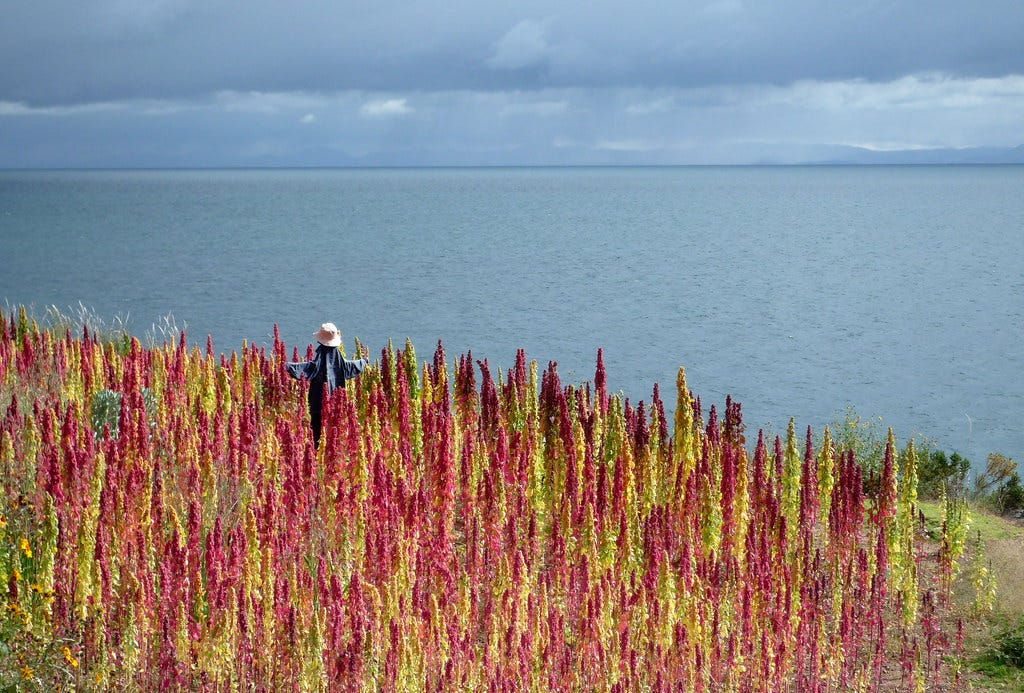

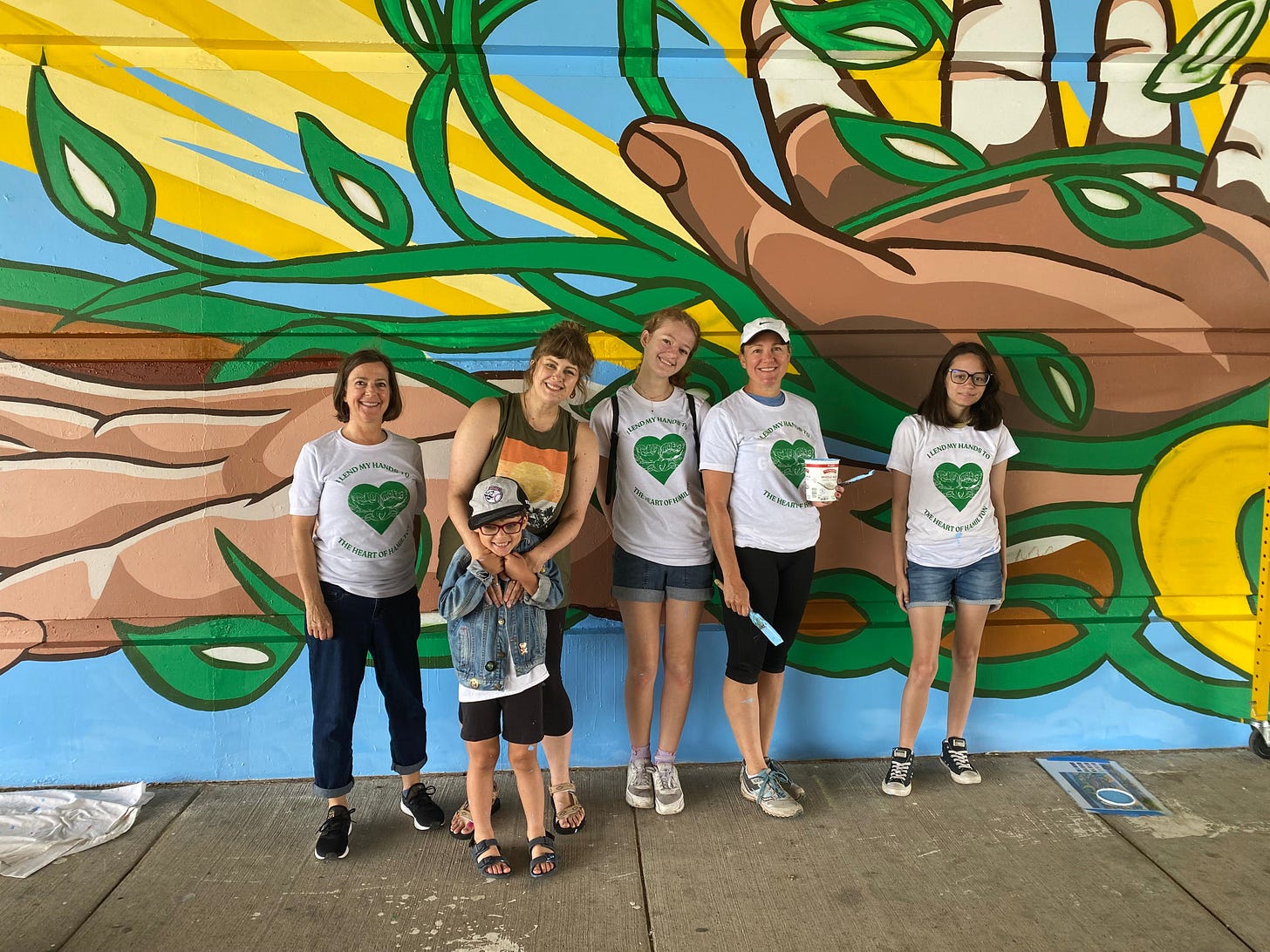
tastes good too!
Love this beautiful article for its heart and generosity of spirit! I will share it with my son. He and his gf eat entirely plant-based foods. I'm still working on shedding my attachment to some non-plant foods, but have them less often than before. Look forward to making the salad. ~:0) Love the mural!